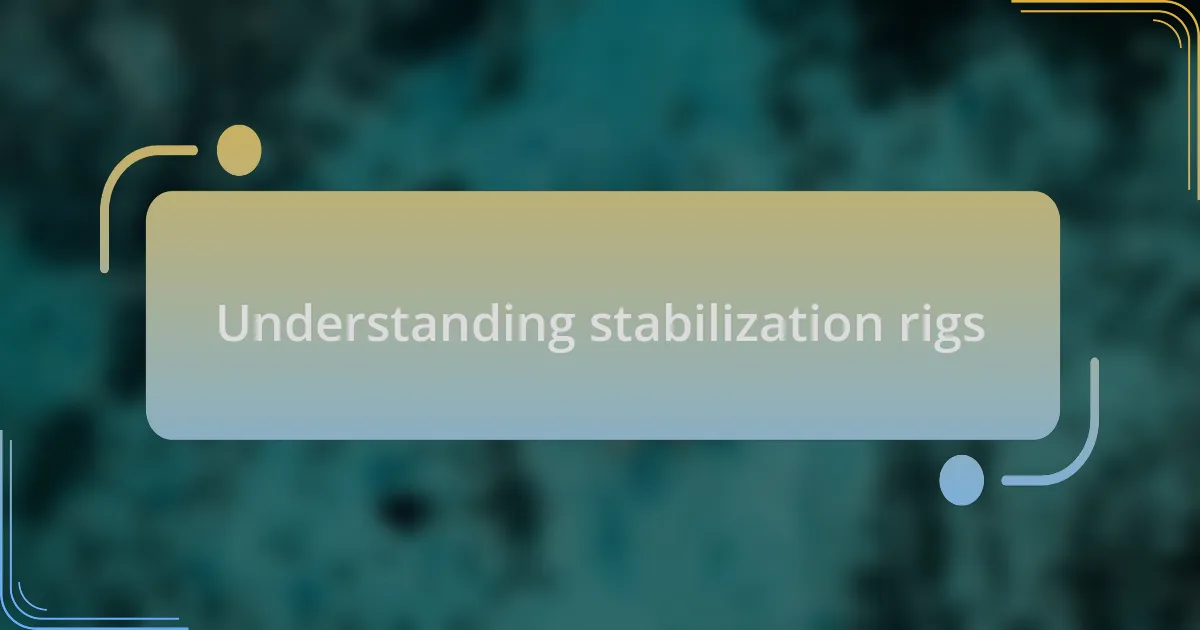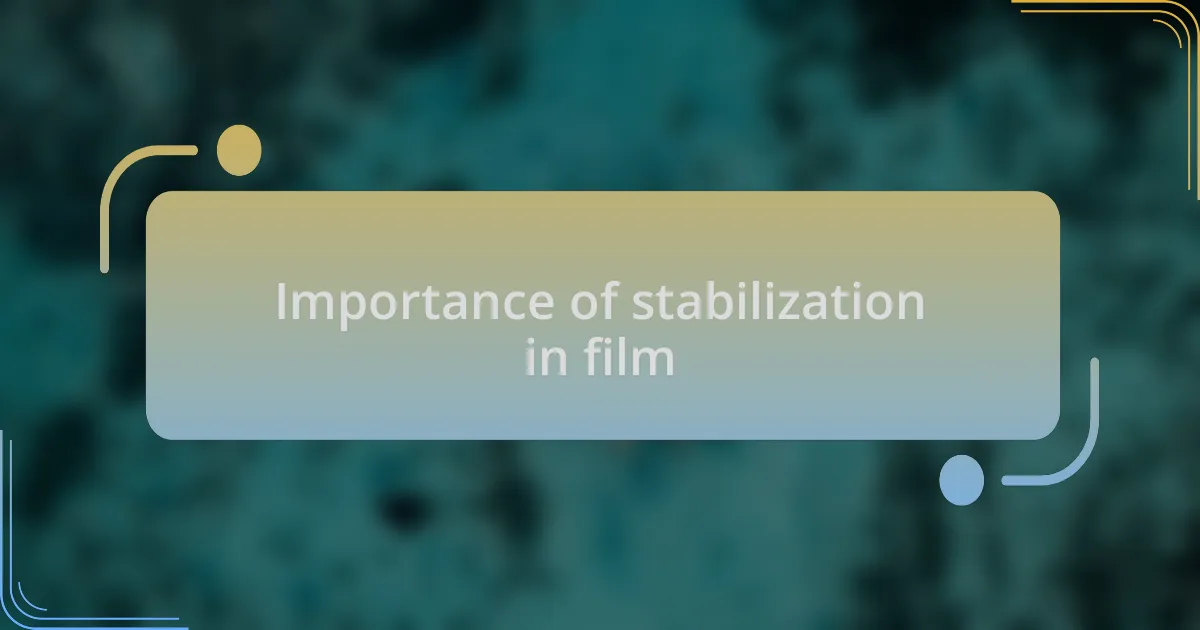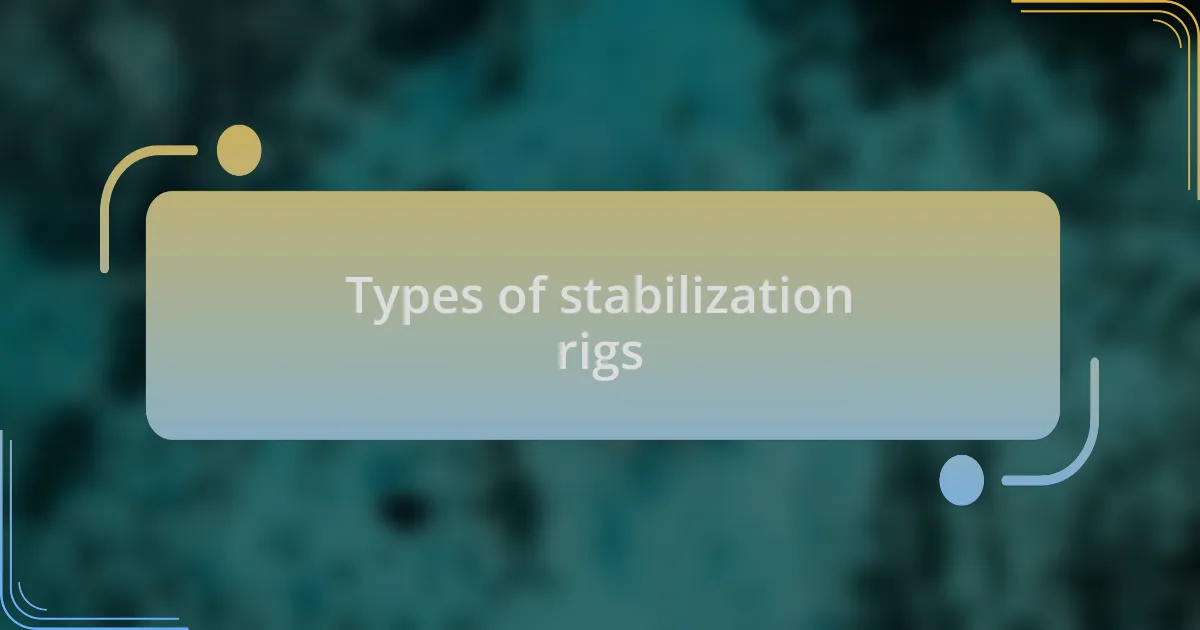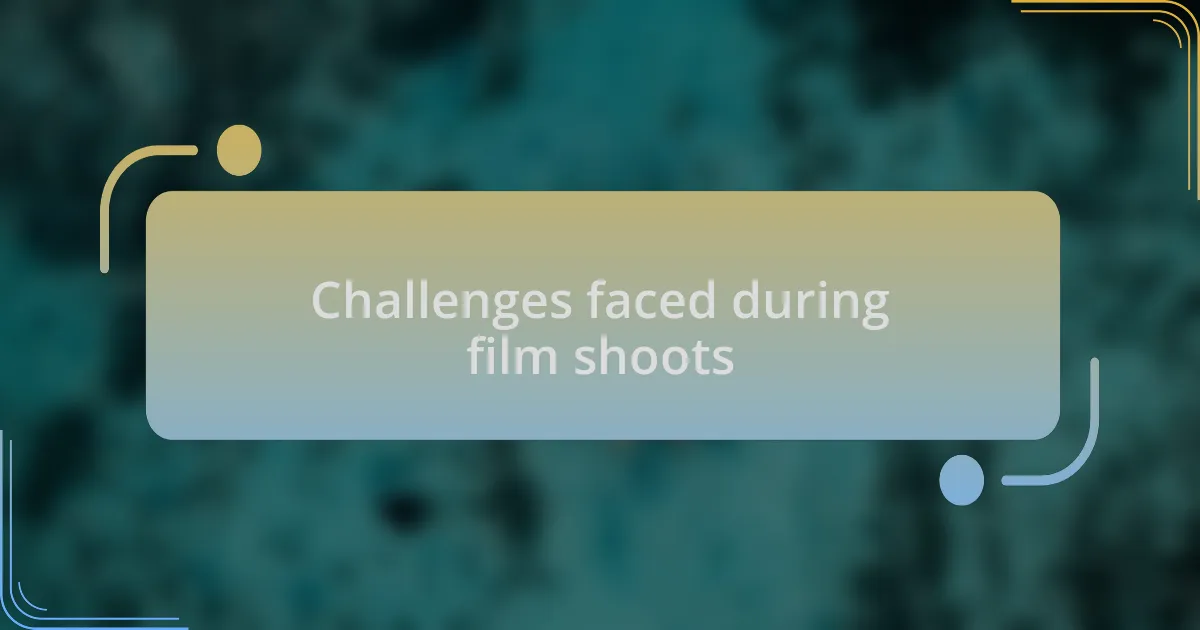Key takeaways:
- Stabilization rigs are crucial for achieving smooth, professional-looking shots in film production, isolating camera movement from the operator’s motions.
- Different rigs like handheld gimbals, steadicams, and tripods serve specific filming needs, enhancing creative possibilities and storytelling immersion.
- Challenges such as unexpected weather, location unpredictability, and crew coordination require adaptability and clear communication during shoots.
- Effective rig use involves balancing the equipment, practicing movements, and maintaining a steady filming pace to achieve high-quality footage.

Understanding stabilization rigs
Stabilization rigs are essential tools in film production, designed to help achieve smooth, fluid shots regardless of the camera’s movement. I recall the first time I used a gimbal rig; the difference it made in my footage was astonishing. Have you ever experienced that moment when you see your shots transform from shaky to cinematic beauty?
The magic of stabilization rigs lies in their ability to isolate the camera’s motion from the operator’s movements. I remember a particularly memorable day on set when I was racing across a field, and thanks to the rig, it felt like I was gliding over the ground. I couldn’t help but think about how a well-stabilized shot can elevate a story and draw the audience deeper into the narrative.
Different types of stabilization rigs include handheld gimbals, steadicams, and drone stabilizers, each offering unique benefits for different shooting scenarios. When working with a steadicam for the first time, I was struck by how intuitive it felt, almost like an extension of my own body. Have you ever thought about how crucial the right equipment is to capturing the vision you have in mind?

Importance of stabilization in film
The importance of stabilization in film cannot be overstated. I vividly recall a project where we shot in a fast-paced environment. Without the right stabilization, the footage would have been jarring and unwatchable. Instead, we captured dynamic movement seamlessly, allowing the audience to feel as though they were part of the action.
When you’re filming a scene that involves a lot of movement, the last thing you want is for your audience to be distracted by shaky shots. There’s something about a well-stabilized camera that provides a level of professionalism and clarity. I remember watching a rough cut of our film, and the smooth transitions made the storytelling so much more immersive. Doesn’t it just make you appreciate the art of filming even more?
Moreover, the right stabilization equipment enhances creative possibilities. On one shoot, using a gimbal allowed me to experiment with unique angles and movements that would have been impossible with a handheld camera. The potential to explore innovative shots often outweighs the struggle of dealing with unwanted shake. How often do we let the tools we use dictate our creativity? In my experience, having a reliable stabilization rig can truly free you to tell the story you envision.

Types of stabilization rigs
When discussing types of stabilization rigs, it’s essential to recognize the variety available, each suited for different filming needs. I have found that handheld gimbals are incredibly popular among filmmakers for their versatility. For instance, during a recent shoot, I used a three-axis gimbal, which helped me achieve fluid motion while running through a crowded street. The ease of movement made it feel less like work and more like an exhilarating dance with the camera.
On another project, we relied on steadicams for their unique ability to isolate the operator’s movements from the camera’s perspective. I distinctly remember the thrill of capturing a long, continuous shot during a wedding ceremony. The steadicam allowed my team to glide smoothly through the crowd, capturing emotional reactions without the jitteriness that handheld shots often struggle with. Have you ever tried shooting something creatively demanding with a steadicam? It can be a game-changer.
Tripods with fluid heads, while sometimes overlooked, provide a different kind of stabilization. I used this type during a documentary shoot where precise panning was essential. The smooth movements made it easier to track subjects without cutting away to stabilize post-shoot, allowing for a more cohesive storytelling flow. In my experience, the right tool can transform the art of filmmaking, showcasing moments as they unfold beautifully and authentically.

Challenges faced during film shoots
Film shoots often come with a unique set of challenges that can test even the most prepared teams. I recall a particularly intense day on set when unexpected weather forced us to adapt quickly. We found ourselves scrambling to protect our gear and rethink our shot list, all while keeping the morale high. Have you ever had to pivot mid-shoot like that? It’s both stressful and exhilarating.
Another challenge I frequently encounter involves the unpredictability of locations. During a shoot in a bustling city, we faced constant interruptions from passersby and traffic. It was frustrating to lose precious shooting time, but I learned to embrace the chaos. I found that some of the best moments come from working with the environment rather than against it. Have you ever captured something serendipitous during a shoot that ended up being a highlight?
Lastly, coordinating the crew and equipment can become a logistical puzzle. On one occasion, our camera operator and sound technician almost missed each other at a critical moment. I remember feeling a rush of adrenaline as I had to coordinate and communicate swiftly, ensuring we were all on the same page when the time came to roll. What strategies do you think are effective for keeping everyone aligned during those high-pressure moments? From my experience, clear communication and flexibility are key to navigating these challenges successfully.

Tips for effective rig use
Using stabilization rigs effectively can make a significant difference in the quality of your shots. One tip I’ve found crucial is ensuring the rig is balanced correctly before shooting. I remember a time when I was in a rush, skipped this step, and ended up with shaky footage that didn’t meet my standards. Have you ever faced this frustrating scenario? Taking those few extra moments to adjust the rig can save a lot of time in post-production.
Another important aspect is to practice different movements with the rig before the actual shoot. I often allocate some time during pre-production to familiarize myself with the rig’s capabilities and limitations. During a recent project, I tried out some sweeping shots, and it amazed me how fluid the motion became once I understood the rig better. What’s your experience with rehearsing movements? I believe that practice not only builds confidence but also unlocks creative shooting possibilities.
Lastly, it’s essential to maintain a steady pace while filming. I’ve noticed that rushing can lead to unintentional jolts, diminishing the smoothness you aim for. During a frantic chase scene, I trained myself to breathe and move deliberately. This approach not only improved the footage but also lowered my anxiety during high-energy sequences. How do you manage your pacing on set? In my view, finding that right rhythm is key to mastering the art of stabilization rig use.